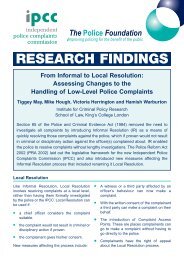Differential treatment in the youth justice system - Equality and ...
Differential treatment in the youth justice system - Equality and ...
Differential treatment in the youth justice system - Equality and ...
Create successful ePaper yourself
Turn your PDF publications into a flip-book with our unique Google optimized e-Paper software.
INTRODUCTIONexplanation is that young people from some of <strong>the</strong> most socially marg<strong>in</strong>al ethnicm<strong>in</strong>ority groups, notably Pakistanis <strong>and</strong> Bangladeshis, have not historically beenover-represented <strong>in</strong> offend<strong>in</strong>g.There currently appears to be a change of mood on this issue, with academics,politicians <strong>and</strong> o<strong>the</strong>r commentators be<strong>in</strong>g prepared to address <strong>the</strong> possibility thatsocial exclusion may be responsible for some ethnic m<strong>in</strong>ority groups’ overrepresentation<strong>in</strong> offend<strong>in</strong>g. For example, <strong>the</strong> House of Commons Home AffairsCommittee (2007) found that one of <strong>the</strong> ‘primary causes’ of <strong>the</strong> over-representationof some ethnic m<strong>in</strong>ority groups <strong>in</strong> <strong>the</strong> crim<strong>in</strong>al process was social exclusion(paragraph 98). Their report argued that young black people are disproportionatelysubject to socio-economic disadvantage that manifests itself <strong>in</strong> a variety of ways.Social exclusion, educational underachievement <strong>and</strong> school exclusion <strong>in</strong>teract toform a web of disadvantage, br<strong>in</strong>g<strong>in</strong>g young black people disproportionately <strong>in</strong>tocontact with crime <strong>and</strong> <strong>the</strong> crim<strong>in</strong>al <strong>justice</strong> <strong>system</strong> as both victims <strong>and</strong> offenders(House of Commons Home Affairs Committee, 2007:53).<strong>Differential</strong> polic<strong>in</strong>gThe possibility that some ethnic groups are more <strong>in</strong>volved than o<strong>the</strong>rs <strong>in</strong> crime may,of course, co-exist with differential polic<strong>in</strong>g. While o<strong>the</strong>r crim<strong>in</strong>al <strong>justice</strong> agencies mayaffect patterns of over-representation at <strong>the</strong> marg<strong>in</strong>s, <strong>the</strong>re are reasons to th<strong>in</strong>k that<strong>the</strong> police can exert a considerable <strong>in</strong>fluence on who enters, <strong>and</strong> who is divertedfrom, <strong>the</strong> <strong>youth</strong> <strong>justice</strong> <strong>system</strong>. Some commentators have argued that <strong>the</strong> polic<strong>in</strong>g ofethnic m<strong>in</strong>ority groups, <strong>in</strong> particular black adults <strong>and</strong> young people, is characterisedby a ‘pervasive, ongo<strong>in</strong>g target<strong>in</strong>g of black areas’ (Bowl<strong>in</strong>g <strong>and</strong> Phillips, 2002:129),deriv<strong>in</strong>g from an association of young black people with crim<strong>in</strong>ality. Macpherson(1999) described this as <strong>in</strong>stitutional racism. Certa<strong>in</strong>ly, police activity plays animportant role <strong>in</strong> ‘recruit<strong>in</strong>g’ ethnic m<strong>in</strong>ority young people to <strong>the</strong> <strong>youth</strong> <strong>justice</strong> <strong>system</strong>(Webster, 2006). Young black people are almost twice as likely as <strong>the</strong>ir white peersto enter <strong>the</strong> crim<strong>in</strong>al <strong>justice</strong> <strong>system</strong> as a consequence of be<strong>in</strong>g stopped <strong>and</strong> searchedby <strong>the</strong> police (Home Affairs Select Committee, 2007: paragraph 166).8






